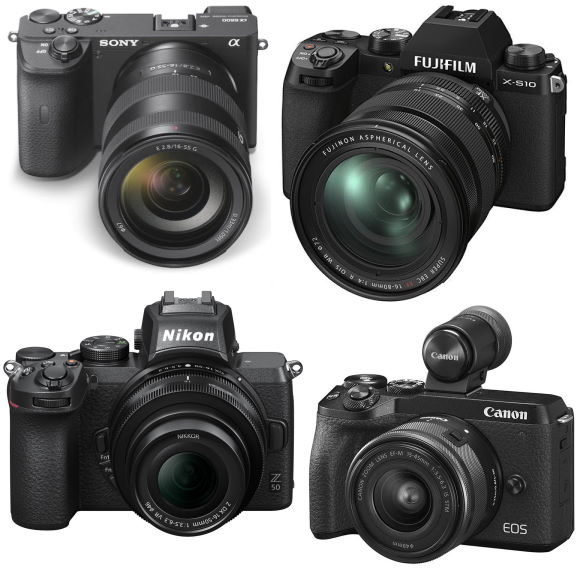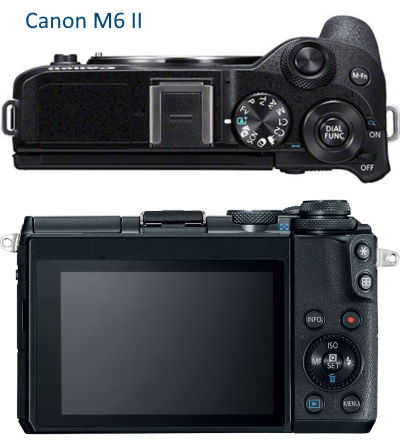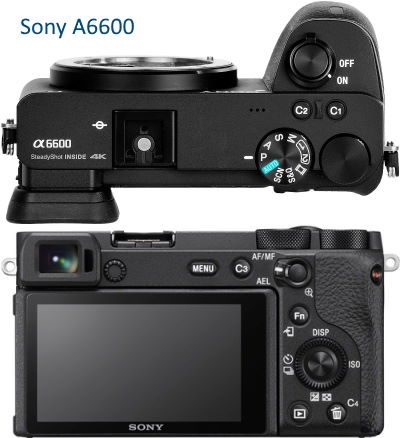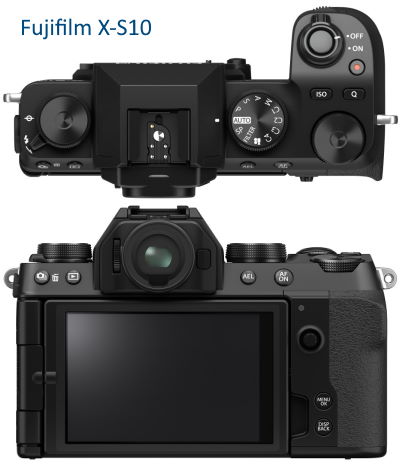Canon EOS M6 II vs Sony A6600 vs Fujifilm X-S10 vs Nikon Z50
In the compact hybrid category, these four cameras are the best and cost $ 1,000 at most. For Canon and Sony these are the highest of the ranges. Fujifilm offers a more pro and heavier model, the X-T4 which we will not talk about here. For the essential parts it's similar to the X-S10 shown here.

Comparing specifications
| Canon EOS M6 II | Sony A6600 | Fujifilm X-S10 | Nikon Z50 | |
|---|---|---|---|---|
| Sensor | APS-C | APS-C | APS-C | APS-C |
| Pixels (million) | 32.5 | 24 | 26 | 21 |
| Resolution in 3:2 | 6960x4640 | 6000x4000 | 6240x4160 | 5568x3712 |
| Resolution in 16:9 | 6960x3904 (27 MP) | 6000x3376 (20 MP) | 6240x3512 (22 MP) | 5568x3128 (17.4 MP) |
| Kit lens | 15-45mm f/3.5-6.3 IS | 18-135mm f/3.5-5.6 OSS | 18-55mm f/2.8-4 OIS | 16-50mm D3.5-6.3 VR |
| Mount | EF-M | E Mount | Fujifilm X | Z |
| Digital zoom | - | 2x à 8x | - | - |
| Sensitivity | ISO 100-25600 | ISO 100-32000 (Extended 50-1024000) |
ISO 160-12800 (Extended 80-51200) |
ISO 100-51200 (Extended 204800) |
| Mechanical shutter | 1/4000 - 30s | 1/4000 - 30s | 1/4000 - 15mn | 1/4000 - 30s |
| Electronical shutter | 1/16000 | 1/4000 - 30s (idem) | 1/32000 - 15mn | 1/4000 - 30s (idem) |
| Silent shutter | yes | yes | yes | yes |
| Bulb mode | yes | yes | 60mn | - |
| Focus points | 143 | 425 | 425 | 209 |
| Autofocus | Dual pixels.
Phase detection. Contrast for 4K video. Eye detection (for still images). |
Hybrid phase detection / contrast detection for images and videos. Eye detection with tracking even for animals. |
Hybrid phase detection / contrast detection for images and videos. Single, continu, manual. Eye detection with tracking. |
Hybrid phase detection / contrast detection for images and videos. Single, continu, manual. Face detection. |
| Burst mech/elec | 14 ips - 30 ips RAW | 11 ips | 30 ips | 5 ips |
| Pre-shot | 0.5s before | - | 10 before + 110 after | - |
| Pictures format | JPEG, RAW CR3 | JPEG, RAW | JPEG, RAW | JPEG, RAW |
| Panorama | - | - | yes | - |
| Timelapse | yes | yes | yes | yes |
| IBIS | - | yes 5 stops | yes 6 stops | - |
| DR bracketing | yes | yes | yes | yes |
| Exposition bracketing | yes | yes | yes | yes |
| Focus bracketing | With kit and some lenses | - | 1-999 images | - |
| WB bracketing | yes | yes | yes | yes |
| Distortion correction | yes | yes | yes | yes |
| Films simulation | - | - | 18 | - |
| Video size | 4K 30/24 fps FHD 120 fps FHD HDR 30 fps |
4K HDR 30/24 fps FHD 120 fps |
4K 30/24 fps FHD 240 fps |
4K 30/24 fps FHD 120 fps + audio |
| Video duration | 30mn | Unlimited | 4K 30mn - FHD 30mn FHD 120p 6mn FHD 240p 3 mn |
30 mn |
| Video files | MPEG 4 / AVC H.264 | MPEG 4 / AVC H.264 | MPEG 4 / AVC H.264 | MPEG 4 / AVC H.264 |
| Vlog | 120 Mbps | 4:2:2 8 bits by HDMI / S-Log3 / HLG / 100 Mbps | 4:2:2 10 bits by HDMI / F-Log / 200 Mbps | |
| Microphone | Stereo + 3.5 jack | Stereo + 3.5 jack | Stereo + 3.5 jack | Stereo + 3.5 jack |
| Earphone | - | yes | By USB-C | - |
| Autonomy | 305 images | 720 images | 325 images | 300 images |
| USB charging | yes | yes | yes | yes |
| Connectors | HDMI, USB 2 Type C | HDMI, Micro USB | HDMI, USB 3.2 Type C | HDMI, Micro USB 2.0 |
| Bluetooth | 4.1 | 4.1 | 4.2 | 4.2 |
| Wi-Fi | 2.4 GHz | 2.4 GHz | 2.4 GHz | 2.4 GHz |
| Integrated flash | 5 m | - | yes | yes |
| Viewfinder | Removable
OLED 2.360K Ratio 4:3 |
OLED 2.360 K 0.7x | OLED 2.360 K | OLED 2360 K 0.68x |
| Touch screen | Full | Focus | Focus and other functions | Full + Icons |
| Movable screen | Tilt 360° | Tilt 180° | Articulated | Tilt 180° |
| Remote control | Bluetooth | IR + Bluetooth | 3.5 jack | Bluetooth |
| Stockage | UHS-II | UHS-I | UHS-I | UHS-I |
| Weather sealing | - | yes | - | Partial |
| Dimensions | 119.6 x 70 x 49.2 | 120 x 66.9 x 69.3 | 126 x 85.1x 65.4 | 126.5 x 93.5 x 60 |
| Weight with battery | 408g | 503g | 465g | 450g |
| Year | 2019 | 2019 | Nov 2020 | Oct 2019 |
| Cost in 2020 (body only) | $850 ( No viewfinder) | $1100 | $1000 | $750 |
Why choose the Canon EOS M6 Mark II
For the first time Canon is offering an APS-C camera that has not been too much crippled. To encourage switching to full frame they remove functions such as fast burst with electronic shutter. However, Canon does not seem prone to offer a high-end APS-C model with an integrated viewfinder. This camera is least suited to 4K video because functions and quality.
- 32.5 MP resolution.
- Focus bracketing with some lenses.
- Pre-shot to not miss an awaited action.
- Touch menu.
- Slightly lower weight and size.
- Inexpensive quality lenses like 11-22mm and 32mm, as well as many adapted EF-S lenses.

Why choose the Sony A6600
The A6600 lacks some very useful functions such as panorama mode, pre-shot and flash, but it has other advantages such as very good autofocus, rain protection, good 4K videos (6k downsampled ) of unlimited duration, and autonomy.
- Stabilization in the body for videos without a tripod.
- Responsive autofocus in 4K video. Best 4K video overall.
- Real-time eye tracking, better autofocus.
- Best dynamic interval.
- C1-C4 buttons to be assigned to some functions.
- Its battery allows twice as many shots as the competitors.
- Weather protection.

Why choose the Fujifilm X-S10
For the first time, Fujifilm is making video an asset and also add body stabilization in a compact format. Even if we go back to a more classic mode dial than the usual Fuji controls, we have enough configurable buttons and dials to control the camera according to our preferences.
- A joystick to move the focus point.
- Modern 26 MP sensor.
- Varied color sets with 18 film simulations, and an auto mode that select between 3 simulations.
- Good quality of images in JPEG.
- Pre-shot allows you to produce continuous images as long as the shutter release button is half-pressed, and when you press the shutter button the last 10 images are saved.
- The only one of the three to have a direct panorama mode in the camera.
- Fast and convenient image transfer in USB 3.2 type C.
- Removes chromatic aberrations of lenses of all brands including manual and vintage.
- You can edit RAW images directly in the camera and convert them to JPEG.
- Starts in 0.4 seconds.

Why choose the Nikon Z50
Currently Nikon offers only 3 APS-C lenses: the 16-50, a 24-70 F2.8 and a 50-250. SLR lenses can be adapted, so it is especially interesting for those who have previously owned an APS-C of the brand and already have a few lenses. For newcomers, it is attractive for its price, its ergonomics and the basic qualities of the photo, but it lacks features.
- Slightly higher low-light capability, like Sony.
- Touch menu and function icons on the screen.
- Well-arranged menu.
- Customizable quick menu "i".
- Waterproof (partially only because of the pop-up flash).
- You can cap the shutter speed and the ISO level together.

It is recommended that you read the camera's online manual before purchasing one to get a better idea of the experience it will offer. It is also important to consider in advance the lenses that you will use.
See also ...
- Canon, Fuji, Sony, Micro 4/3, choose a system.
- Fujifilm X-E3 vs X-T200 vs X-S10 vs X-T30.
- Canon EOS M50 vs Sony A6500/A6400 vs Fujifilm X-T30.






